Vintage Treasures: The Best of Philip K. Dick
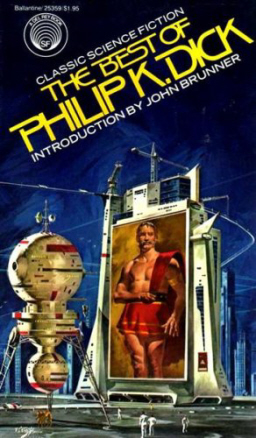 I didn’t know anything about Philip K. Dick when The Best of Philip K. Dick was released in 1977. That was the year Star Wars came out and I was more interested in trying to make a light saber out of my sister’s hair dryer.
I didn’t know anything about Philip K. Dick when The Best of Philip K. Dick was released in 1977. That was the year Star Wars came out and I was more interested in trying to make a light saber out of my sister’s hair dryer.
I wasn’t alone (about Dick, not my obsession with my sister’s hair dryer). Philip K. Dick was a midlist paperback science fiction writer in the mid-70s, with few awards and only a handful of successful novels to his name, largely unknown except inside the genre. As Robert Silverberg observed in his famous comments on full-time SF writers, “Phil Dick was a full-timer, but lived at the poverty level.”
Dick was an unusual choice for Lester del Rey’s Classics of Science Fiction line for another reason. If you’ve been following the entries so far (see below for a complete list of the titles we’ve covered), you know that a typical volume consists of long out-of-print pulp stories by a writer who later achieved some measure of fame, usually for their novels.
The most recent story in last week’s entry, for example, The Best of John W. Campbell, was “Cloak of Aesir,” originally published in 1939. Similarly with The Best of Henry Kuttner (most recent entry from 1946), C.L. Moore (1946), Stanley Weinbaum (1936), and others.
By contract, the earliest story in The Best of Philip K. Dick, “Beyond Lie the Wub,” originally appeared in 1952. He’d barely been published for two decades by the time this book arrived, which didn’t fit the profile of Del Rey’s other choices at all. In fact, in many ways Dick was the most contemporary subject Del Rey chose for his select line of collections.
I can only conclude that Del Rey saw something special in Dick’s short stories. He wasn’t the only one, either — by the late 70s, the brilliant work being done by Dick at short length was becoming obvious to his fellow writers, even if wider recognition still eluded him. The blurbs on the inside cover reflect this. Here’s Norman Spinrad:
He has produced the most significant body of work of any science-fiction writer.
And here’s Rolling Stone:
There’s something about ordinary reality that causes it to go all shimmery in the presence of Philip K. Dick… [his fans believe he] is now on the edge of a popularity surge similar to what happened to Kurt Vonnegut in the late Sixties.
Prophetic words. Of the roughly two dozen writers Del Rey showcased in the Classics of Science Fiction line, I think it’s safe to say that none experienced the surge in popularity Dick did over the next two decades.
[Click on any of the images in this article for larger versions.]
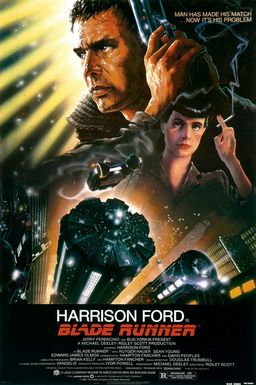 One thing’s for sure: while many still have a handful of their most popular works in print, over three decades after these collections appeared, Dick is unique in that virtually his entire body of work is still available and still being read today.
One thing’s for sure: while many still have a handful of their most popular works in print, over three decades after these collections appeared, Dick is unique in that virtually his entire body of work is still available and still being read today.
Dick’s fame started to blossom in the late seventies and early eighties. It began, most certainly, when he won a Hugo Award for The Man in the High Castle (1962), his ninth published novel. While he won serious acclaim for later work, he never won another major award and The Man in the High Castle remains his most popular and enduring novel.
In 1974 came Flow My Tears, The Policeman Said, the tale of television celebrity Jason Taverner, who awakens in a parallel universe where he is unknown. It was nominated for a Nebula, Hugo, and Locus Award, but won only the John W. Campbell Award. In 1997, A Scanner Darkly was nominated for the Campbell, and won the British Science Fiction Award that year.
And then, in 1982, came Blade Runner.
Blade Runner was based on Dick’s 1968 Nebula nominee Do Androids Dream of Electric Sheep? It was directed by Ridley Scott (Alien) and stared Harrison Ford, hot off the blockbuster success of Raiders of the Lost Ark.
Despite everything it had going for it — including a big budget and stunning visual design — Blade Runner wasn’t a commercial success. It was trounced at that box office that summer by The Thing, Star Trek II: The Wrath of Khan, and especially E.T. the Extra-Terrestrial.
But it has since become recognized as one of the true classics of SF cinema. It won the Hugo Award for Best Dramatic Presentation and a Special Achievement Award from the London Critics Circle Film Awards. It currently has a 91% rating at Rotten Tomatoes.
That was only the beginning. After Blade Runner, Dick achieved the kind of fame that most SF writers can only dream of. Once Hollywood got a taste of the mind-bending imagination of Philip K. Dick, there was no turning back.
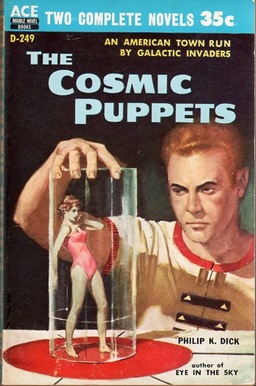 Over the last two decades, there’s scarcely been a 3-year gap between film productions of Philip K. Dick properties. They include many big-budget features, such as Total Recall (1990, and a remake in 2012), Screamers (1995), Minority Report (2002), Paycheck (2003), A Scanner Darkly (2006), Next (2007), and The Adjustment Bureau (2011).
Over the last two decades, there’s scarcely been a 3-year gap between film productions of Philip K. Dick properties. They include many big-budget features, such as Total Recall (1990, and a remake in 2012), Screamers (1995), Minority Report (2002), Paycheck (2003), A Scanner Darkly (2006), Next (2007), and The Adjustment Bureau (2011).
Today, Philip K. Dick is one of the most recognized names in science fiction. Arguably, he is more famous and recognizable than any of the “big three” who dominated SF in the late 20th Century: Arthur C. Clarke, Isaac Asimov, and Robert E. Heinlein. He has nearly as many novels in print today as Asimov and Clarke combined.
In 2005, Time magazine named his 1969 novel Ubik one of the one-hundred greatest English-language novels published since 1923. He was the first science fiction writer to be included in the prestigious Library of America series, with three omnibus volumes edited by Jonathan Lethem.
Sadly, Dick didn’t live to enjoy this late flowering of his career. He died of a stroke on March 2, 1982, at the age of 53. He never saw the release of Blade Runner, although he did see some of the production stills and set design.
Dick began his career publishing short novels with Ace, including a number of noted Ace Doubles, such as Solar Lottery (1955), The World Jones Made (1956), The Man Who Japed (1956), The Cosmic Puppets (1957), Eye in the Sky (1957), Dr. Futurity (1960), and Vulcan’s Hammer (1969).
His later novels — including Counter-Clock World (1967), Ubik (1969), We Can Build You (1972), Flow My Tears, The Policeman Said (1974), A Scanner Darkly (1977), and Radio Free Albemuth (1985) — appeared from a wide range of publishers and won him an increasing audience for their daring and diversity, as well as his continued fascination with human identity and the concept of free will.
I have a checkered history with Philip K. Dick. I read much of his major work, of course, but my most memorable experiences with him have been as a bookseller. Including that time at Dragon*con when a lovely young woman wandered by the Black Gate booth and picked up a paperback copy of Eye in the Sky.
“Do you like Dick?” I asked innocently.
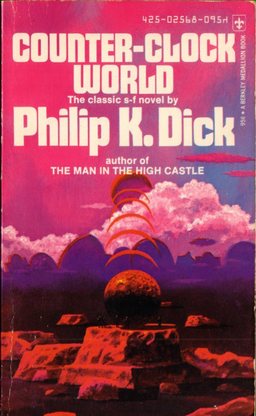 There’s no innocent way to ask a woman if she likes Dick. She dropped the book and bolted. She vanished quickly enough, but it was a looong time before the laughter from the booksellers around me died down. For the next three days, whenever there was a quiet moment in the booth someone would mutter, “Do you like Dick?” and everyone would burst out laughing again.
There’s no innocent way to ask a woman if she likes Dick. She dropped the book and bolted. She vanished quickly enough, but it was a looong time before the laughter from the booksellers around me died down. For the next three days, whenever there was a quiet moment in the booth someone would mutter, “Do you like Dick?” and everyone would burst out laughing again.
Philip K. Dick taught me a lot about book collecting — and not just how to phrase my questions more delicately. His earliest paperbacks — especially his Ace Doubles — command extraordinary prices in the collector’s market, as I wrote about after my experience selling Dick paperbacks at the Printer’s Row book fair in 2011. (You can read about it in my article Selling Philp K. Dick.)
In describing his stories — which question the very nature of reality, and especially the truth of human existence — Dick famously said:
In my writing I even question the universe; I wonder out loud if it is real, and I wonder out loud if all of us are real.
The Best of Philip K. Dick collects 19 stories published between 1952 and 1974. The introduction was by John Brunner and he encapsulated the prophetic nature of much of Dick’s work, and its enduring appeal to critics, when he said:
[Dick is] the most consistently brilliant science-fiction writer in the world… But I tell you this straight up: I do not want to live in the sort of world Dick is good at describing… Maybe if a lot of people read Dick’s works I’ll stand a better chance of not living in that world.
The book contains “Second Variety” (basis for the movie Screamers), “Paycheck” (adapted as the Ben Affleck film Paycheck), and many other classic tales, including “Oh, To Be a Bobel!” and “A Little Something For Us Tempunaunts.”
Unlike many of the other titles in the Classics of Science Fiction line, this one had no hardcover first edition from the Science Fiction Book Club.
Here’s the back cover, with Lester Del Rey’s story descriptions:
The distinctive cover is by Vincent di Fate.
Dick provided the “Afterthoughts,” which is filled with insightful and amusing anecdotes and commentary:
As to what the stories in this collection mean, I will not cite the usual copout that the story must speak for itself, but rather the copout that I don’t really know… One time a whole class of kids wrote me about my story “The Father-thing,” and every kid wanted to know where I got my idea. That was easy, because it was based on childhood memories of my father; but later on, in re-reading my answers, I noticed that I never said the same thing twice. With all intent at honesty, I gave each kid a different answer. I guess this is what makes a fiction writer…
So now, briefly, to consider these stories themselves. “Beyond Lies the Wub”: My first published story, in the most lurid of all pulp magazines on the stands at the time, Planet Stories. As I carried four copies into the record store where I worked, a customer gazed at me and them, with dismay, and said, “Phil, you read that kind of stuff?” I had to admit I not only read it, I wrote it…
“Second Variety”: My grand theme — who is human and who only appears (masquerades) as a human? — emerges most fully. Until we can individually and collectively be certain of the answer to this question, we face what is, in my view, the most serious problem possible. Without answering it adequately, we cannot even be certain of our own selves. I cannot even know myself, let alone you. So I keep working on this theme; to me nothing else is as important a question. And the answer comes very hard.
Here’s the contents:
Table of Contents
Introduction: The Reality of Philip K. Dick, by John Brunner
“Beyond Lies the Wub” (Planet Stories, July 1952)
“Roog” (The Magazine of Fantasy and Science Fiction, February 1953)
“Second Variety” (Space Science Fiction, May 1953)
“Paycheck” (Imagination, June 1953)
“Impostor” (Astounding Science Fiction, June 1953)
“Colony” (Galaxy Science Fiction, June 1953)
“Expendable” (The Magazine of Fantasy and Science Fiction, July 1953)
“The Days of Perky Pat” (Amazing Stories, December 1963)
“Breakfast at Twilight” (Amazing Stories, July 1954)
“Foster, You’re Dead” (Star Science Fiction Stories No. 3, 1955)
“The Father-Thing” (The Magazine of Fantasy and Science Fiction, December 1954)
“Service Call” (Science Fiction Stories, July 1955)
“Autofac” (Galaxy Science Fiction, November 1955)
“Human Is” (Startling Stories, Winter 1955)
“If There Were No Benny Cemoli” (Galaxy Magazine, February 1964)
“Oh, to Be a Blobel!” (Galaxy Magazine, February 1964)
“Faith of Our Fathers” (Dangerous Visions, 1967)
“The Electric Ant” (The Magazine of Fantasy and Science Fiction, October 1969)
“A Little Something for Us Tempunauts” (Final Stage, 1974)
Afterthoughts by the Author, by Philip K. Dick
The Best of Philip K. Dick was published by Ballantine Books in March 1977. It is 450 pages and was priced at $1.95. There is no digital edition.
The last volume we covered was The Best of John W. Campbell. So far we’ve covered the following volumes in the Classics of Science Fiction line (in order of publication):
The Best of Stanley G. Weinbaum
The Best of Fritz Leiber
The Best of Henry Kuttner
The Best of John W. Campbell
The Best of C M Kornbluth
The Best of Philip K. Dick
The Best of Fredric Brown
The Best of Edmond Hamilton
The Best of Murray Leinster
The Best of Robert Bloch
The Best of Jack Williamson
The Best of Hal Clement
The Best of James Blish
The Best of John Brunner
See all of our recent Vintage Treasures here.
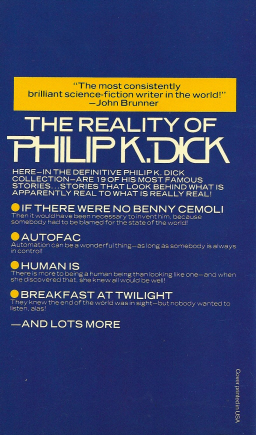
[…] of Fritz Leiber The Best of Henry Kuttner The Best of John W. Campbell The Best of C M Kornbluth The Best of Philip K. Dick The Best of Edmond Hamilton The Best of Murray Leinster The Best of Robert Bloch The Best of Jack […]
[…] of Fritz Leiber The Best of Henry Kuttner The Best of John W. Campbell The Best of C M Kornbluth The Best of Philip K. Dick The Best of Edmond Hamilton The Best of Murray Leinster The Best of Robert Bloch The Best of Jack […]
I think this was one of the hardest volumes in this series to find, if not the hardest. It’s also the one I’ve seen the fewest copies of over the years.
I loved the paranoia in some of the stories in this volume. While I’ve not read a great many of Dick’s novels, I’ve enjoyed most of the ones I have. Still, I think I enjoy his short work more.
Keith,
Dick is absolutely one of the most collectible SF authors. Since a lot of his work appeared first in paperback, there’s a lot of rare book collectors who usually ignore paperbacks out there, snapping up paperback copies of his early novels.
Still, while some of Dick’s books are becoming scarce, there’s still generally a good supply. I’ve had no trouble buying lots containing some of his most sought-after titles for very reasonable prices, and I think that’s part of what’s kept the market from getting too hot. For example, copies of THE BEST OF PHILIP K. DICK are available on Amazon in good condition for $11 and up… not bad at all for a 35-year old paperback.
http://www.amazon.com/Best-Philip-K-Dick/dp/0345253590/
That’s much better than, say, the Hal Clement or James Blish volumes (both of which start at a penny), but still behind THE BEST OF JOHN W. CAMPBELL, which starts at around $13.
http://www.amazon.com/The-Best-John-W-Campbell/dp/0345249607/
I have about half a dozen of his early Ace paperbacks, and I’m hanging on to them.
[…] last volume we covered was The Best of Philip K. Dick. So far we’ve covered the following volumes in the Classics of Science Fiction line (in […]
[…] Vintage Treasures: The Best of Philip K. Dick […]
[…] of Fritz Leiber The Best of Henry Kuttner The Best of John W. Campbell The Best of C M Kornbluth The Best of Philip K. Dick The Best of Fredric Brown The Best of Edmond Hamilton The Best of Murray Leinster The Best of […]
[…] of Fritz Leiber The Best of Henry Kuttner The Best of John W. Campbell The Best of C M Kornbluth The Best of Philip K. Dick The Best of Fredric Brown The Best of Edmond Hamilton The Best of Murray Leinster The Best of […]
[…] of Fritz Leiber The Best of Henry Kuttner The Best of John W. Campbell The Best of C M Kornbluth The Best of Philip K. Dick The Best of Fredric Brown The Best of Edmond Hamilton The Best of Murray Leinster The Best of […]
[…] of Fritz Leiber The Best of Henry Kuttner The Best of John W. Campbell The Best of C M Kornbluth The Best of Philip K. Dick The Best of Fredric Brown The Best of Edmond Hamilton The Best of Murray Leinster The Best of […]
[…] of Fritz Leiber The Best of Henry Kuttner The Best of John W. Campbell The Best of C M Kornbluth The Best of Philip K. Dick The Best of Fredric Brown The Best of Edmond Hamilton The Best of Murray Leinster The Best of […]
[…] of Fritz Leiber The Best of Henry Kuttner The Best of John W. Campbell The Best of C M Kornbluth The Best of Philip K. Dick The Best of Fredric Brown The Best of Edmond Hamilton The Best of Murray Leinster The Best of […]